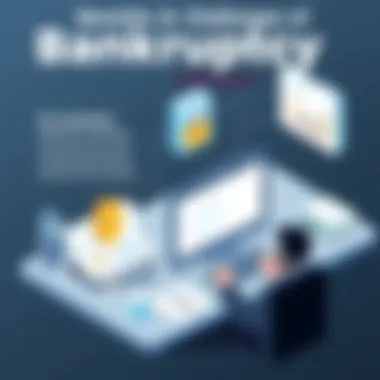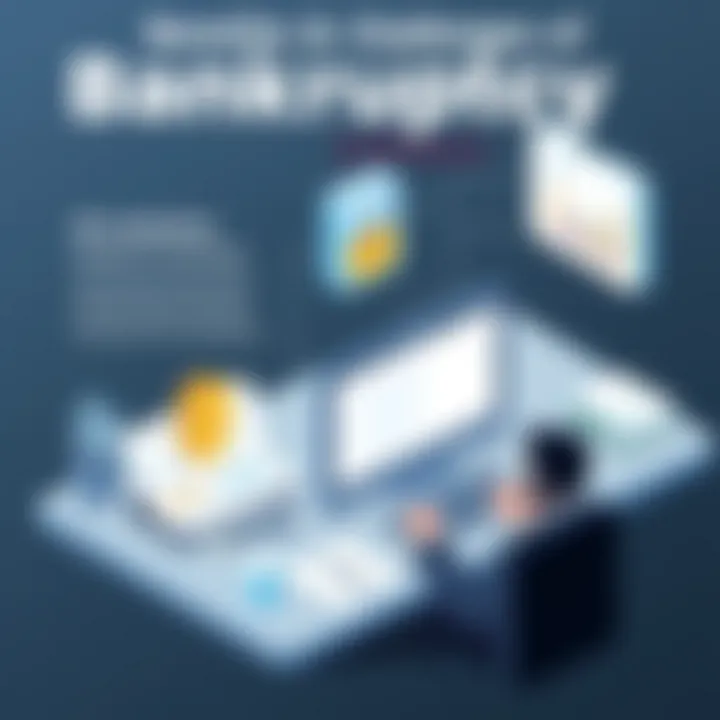Bankruptcy Software: A Detailed Overview for Businesses


Intro
Navigating the labyrinth of bankruptcy is no small feat, especially for businesses facing financial turmoil. In such trying times, entering the world of bankruptcy software can seem as daunting as walking a tightrope. Yet, understanding the intricacies of these specialized tools can provide a lifeline for organization and clarity when it matters most. This article will be your compass, guiding you through the complex landscape of bankruptcy software, illuminating its essential features, associated costs, and the future trajectory of this technology.
Key Features
Overview of Features
Bankruptcy software stands out for several reasons, each contributing to its pivotal role in the insolvency process. At its core, it simplifies what is often a chaotic experience. Let's break down the features that make this software indispensable for businesses in distress:
- Document Management: Streamlining the storage and retrieval of financial documents
- Data Reporting: Advanced reporting tools for insightful analysis and decision-making
- Automated Workflows: Reducing manual tasks, ensuring efficiency and accuracy
- Client Communication Tools: Facilitating seamless interaction between clients and their advisors
- Compliance Checks: Assisting with adherence to legal requirements, ensuring no step is missed
These powerful functionalities coalesce to create an ecosystem that minimizes errors while maximizing efficiency, providing clarity amidst chaos.
Unique Selling Points
What truly sets apart various bankruptcy software options are their unique selling points, which cater to diverse needs within the world of insolvency management.
- User Interface Design: Some software boast an intuitive interface, allowing even the least tech-savvy users to navigate with ease.
- Customization Options: The flexibility to tailor features that align with a specific organization’s needs can be a game changer.
- Integration Capabilities: Seamless integration with existing accounting systems allows for a smooth transition without disrupting workflow.
- Robust Security Measures: Given the sensitive nature of financial information, some platforms offer top-notch security protocols to protect data integrity.
"In choosing the right bankruptcy software, it’s vital to weigh how each feature aligns with your organization's specific goals and needs."
Pricing Structure
Tiered Pricing Plans
Just like a well-crafted ad sits on a high shelf, pricing for bankruptcy software can be a tricky affair, often reflecting a spectrum of services offered. Generally categorized into tiered plans, businesses can select the level of functionality that fits their requirements and budget.
- Basic Plan: Ideal for startups and small firms, offering core features necessary to manage bankruptcy efficiently.
- Mid-range Plan: Adding features like enhanced reporting and consultation options, suitable for growing businesses.
- Premium Plan: Designed for medium to large enterprises with complex needs, providing comprehensive tools and support.
Features by Plan
The features associated with each pricing plan can significantly differ, which is why understanding these disparities is essential.
- Basic Plan: Document management, basic compliance checks, limited reporting.
- Mid-range Plan: Everything in Basic plus advanced data reporting and client communication tools.
- Premium Plan: All features from both Basic and Mid-range, with added customization options and priority customer service.
Understanding these pricing structures empowers decision-makers in selecting the best-equipped software, ensuring they strike the right balance between budget and functionality.
For more insights, you can check out resources such as Wikipedia, and Britannica for a deeper look into bankruptcy processes and relevant legislation.
Understanding Bankruptcy Software
In today’s complex financial landscape, the role of bankruptcy software is akin to having a reliable compass in a stormy sea. It serves as a guiding light for businesses that find themselves navigating the treacherous waters of insolvency. Understanding bankruptcy software entails appreciating its multifaceted role in managing cases effectively, ensuring compliance, and enhancing overall operational efficiencies.
When it comes to bankruptcy cases, every detail counts. This software is designed to help attorneys, accountants, and financial advisors manage the various aspects of a bankruptcy case. From filing necessary documents to tracking client interactions, the software streamlines processes that are often cumbersome and laden with administrative hurdles.
Definition of Bankruptcy Software
Bankruptcy software is a specialized tool aimed at assisting legal and financial professionals in managing cases related to insolvency. Think of it as a digital toolbox where one can find everything needed to handle bankruptcy proceedings efficiently. This software significantly reduces the workload associated with filing, client management, and compliance reporting, allowing professionals to focus on case strategy rather than getting bogged down by paperwork.
For instance, when a debtor files for bankruptcy protection, the software aids in generating automatic notifications, preparing petitions, and creating a detailed financial summary. More than just a digital filing cabinet, it acts as a comprehensive case management system, helping professionals stay organized and effective.
Purpose and Importance
The purpose of bankruptcy software extends beyond mere convenience; it plays a critical role in ensuring that practitioners adhere to legal requirements while providing a streamlined experience for clients. A well-designed system can significantly impact the outcomes for both debtors and creditors. Here are some key aspects to consider:
- Efficiency Boost: By automating routine tasks, bankruptcy software can shave precious hours off busy professionals’ schedules.
- Accuracy in Reporting: The software minimizes human error by standardizing input processes and ensuring that the right forms are filled out accurately and on time.
- Regulatory Compliance: It often includes features that help firms stay updated with changing regulations, thus avoiding pitfalls that could result from non-compliance.
- Streamlined Communication: Client communication tools inherent in bankruptcy software facilitate better interaction between professionals and clients, allowing for a quicker resolution of inquiries.
- Enhanced Financial Oversight: With built-in analytics and reporting functionalities, firms can track performance and financial metrics that reveal insights into both individual cases and overall practice effectiveness.
In essence, understanding bankruptcy software is fundamental for professionals who want to cut through the noise of bankruptcy procedures. It not only caters to immediate operational needs but also fosters long-term growth and sustainability in legal practices. The choice of platform can make or break the efficiency of a firm handling bankruptcy cases.
Key Features of Bankruptcy Software
Bankruptcy software has become a backbone for law firms and financial professionals dealing with insolvency. The importance of understanding the key features of such software lies in its ability to increase operational efficiency, reduce human error, and streamline communication among all stakeholders. As we delve into the specific features, it's clear that these tools are not just add-ons; they are pivotal to managing complex bankruptcy cases effectively.


Case Management
Case management is one of the primary cornerstones of bankruptcy software. This function allows users to track all aspects of a case from initiation to resolution. With effective case management features, legal professionals can manage timelines, deadlines, and all relevant documentation in one central hub. This reduces the risk of missed deadlines, which can be catastrophic in bankruptcy proceedings.
Key elements include:
- Task Lists: Assign and track tasks for team members.
- Calendar Integration: Synchronizes deadlines to keep everyone on the same page.
- Status Tracking: Easily see the progress of cases in real-time.
Moreover, the adaptability of case management systems means they can be tailored to suit specific needs, making them essential for firms handling varying case types.
Document Management
A robust document management system is integral for organizing the vast amount of paperwork involved in bankruptcy cases. Given the sensitive nature of the documents, having a secure yet accessible system is non-negotiable. Features worth noting include:
- Cloud Storage: Allows for easy access from anywhere and minimizes the risk of loss.
- Version Control: Ensures that the most current document is always being used in proceedings, reducing confusion.
- Search Functions: Quickly locate documents without sifting through endless files.
These features not only save time but also ensure compliance with legal standards regarding document retention and security. The ease of attaching and sharing documents directly within the software streamlines workflows significantly.
Client Communication Tools
Effective communication with clients is vital, especially in the often tense environment surrounding bankruptcy. Many bankruptcy software options come equipped with client communication tools that enhance engagement and transparency. Features might include:
- Secure Messaging: Allows for direct and secure communication between clients and professionals.
- Client Portals: Clients can access their information, case status, and documents at any time.
- Automatic Updates: Keep clients informed about their case progress without constant manual checking.
By improving communication, bankruptcy software fosters trust and enhances the overall client experience. It also saves professionals a great deal of time by minimizing the back-and-forth that often plagues legal proceedings.
Financial Reporting and Analytics
Understanding the financial health of a client is at the heart of bankruptcy work. Therefore, solid reporting and analytics features are essential in bankruptcy software. These tools enable professionals to generate reports that provide insights into asset valuation, liabilities, and performance metrics. Crucial components include:
- Customizable Reports: Users can tailor reports to focus on specific aspects relevant to a case.
- Trend Analysis: Spot patterns over time, helping to make more informed decisions.
- Interactive Dashboards: Visual representations of financial data make comprehension easier for both clients and professionals.
The ability to quickly analyze and present financial data can enhance negotiating power in bankruptcy cases, ensuring better outcomes for clients.
Compliance Features
In the world of bankruptcy, compliance with federal and state regulations is critical. Bankruptcy software is designed to help ensure adherence to these regulations through numerous compliance features. Noteworthy elements include:
- Built-In Checklists: Helps ensure that all necessary steps are taken for compliance.
- Automatic Updates: Software updates ensure that users are always operating under the latest regulations.
- Audit Trails: Provides records of all actions taken in relation to compliance, which is particularly useful for accountability and audits.
Such compliance features not only help in safeguarding against penalties but also instill confidence among clients that their legal representatives are managing their cases with diligence and care.
Benefits of Using Bankruptcy Software
In the complex realm of financial distress, bankruptcy software stands as a beacon of solution, streamlining processes that would otherwise be fraught with inefficiencies and errors. The importance of utilizing such software cannot be overstated. It not only enhances operational dynamics but also fosters a more transparent, accurate, and client-friendly atmosphere. Let’s break down the primary benefits that bankruptcy software offers to organizations grappling with insolvency issues.
Increased Efficiency
Efficiency is the pulse of any successful endeavor. When organizations integrate bankruptcy software into their operations, they experience remarkable improvements in workflow. Tasks that once took hours or even days can now be accomplished in a fraction of that time. This is due to various automation features, like automated document generation and case tracking. With software like BankruptcyPro or PacerPro, the need for manual data entry diminishes significantly. Instead of spending countless hours poring over paperwork, teams can allocate their time towards strategy and client care.
Moreover, the ability to handle multiple cases simultaneously with ease can greatly reduce bottlenecks. Workflow automation features ensure that deadlines are met promptly, thus elevating client satisfaction. In a high-pressure field like bankruptcy, every minute counts, and software that provides the means to harness time effectively can be the difference between success and faltering.
Improved Accuracy
No one wants errors when it comes to something as delicate as bankruptcy. The stakes are high, and the repercussions of a simple oversight can be dire. Bankruptcy software minimizes human error through precise data management systems. Automated validations can ensure that the entered data adheres to regulatory standards, thereby drastically reducing the risk of inaccuracies.
For instance, when clients submit their financial disclosures, software like Harris & Harris performs real-time checks against required fields and formats. If something’s amiss, the software flags it, leading users to correct it before submission. This attention to detail is pivotal in avoiding costly mistakes and potential legal ramifications. Additionally, accurate data analytics can aid in making informed decisions, ultimately leading to favorable outcomes for clients and attorneys alike.
Enhanced Client Experience
A streamlined process doesn’t just help the organizational side; it profoundly impacts the client experience. Clients often find themselves in distressing situations when seeking bankruptcy relief. Efficient and transparent handling of their cases can give them peace of mind—a significant emotional component during a tough time.
Bankruptcy software enhances communication, allowing for real-time updates and easy access to case information. Platforms such as My Case offer portals where clients can track their case statuses and communicate with their attorneys.


This level of accessibility fosters trust and strengthens the attorney-client relationship. Being able to see progress through interactive interfaces can empower clients and help calm their anxieties. By showing them that their concerns are being addressed systematically, you create a supportive atmosphere, which is essential in these circumstances.
"Investing in robust bankruptcy software is not just about efficiency; it's about creating an experience that mitigates the distress of financial turmoil for clients."
Challenges in Bankruptcy Software Implementation
When it comes to adopting bankruptcy software, organizations often encounter a number of hurdles that can create roadblocks. These challenges, while seemingly daunting, should be approached with careful planning and awareness. Understanding the nuances of these difficulties can provide a foundation for successful implementation, ultimately enhancing the effectiveness of bankruptcy processes.
Integration with Existing Systems
One of the most pressing issues that companies face is the integration of new bankruptcy software with their current systems. Often, organizations have established workflows and tools in place, and incorporating fresh software requires a careful balancing act. The disconnect that can arise from merging different technologies can lead to complications such as data inconsistencies and operational delays.
To make the integration process smooth, it's crucial to evaluate how the new software interacts with existing applications. A thorough needs assessment before choosing a software solution can reveal potential integration pitfalls. Additionally, opting for software with robust APIs or pre-built connectors can simplify the merging process. An organization might consider engaging IT professionals for greater insights. The expertise they bring can ensure that any new implementation aligns well with the existing technology landscape, rather than adding complexity.
User Training Requirements
No matter how sophisticated a software piece is, it is only as good as the users behind it. That’s why user training emerges as a significant challenge. Employees must be equipped with proper skills to navigate the new system, and without adequate training, frustrations are likely to arise.
Think about it this way: tossing someone into a deep end without giving them a chance to swim isn’t fair. Allocating resources for training sessions is not merely an afterthought; it's an essential component of implementation, ensuring that users feel comfortable and confident. Organizations should consider rolling out phased training programs and offering ongoing support. Utilizing various training methods—whether it be hands-on workshops, video tutorials, or even one-on-one mentoring—can cater to different learning styles within the team. This investment in education can lead to a quicker adoption and greater overall success.
Data Security Concerns
Data security is an unavoidable topic in today’s world. As more organizations migrate sensitive financial data online, the potential for breaches grows, raising valid concerns. Implementing bankruptcy software without addressing security can put both the organization and its clients at risk.
Navigating the realm of data security involves a multifaceted approach. First off, it’s essential to look into how the software provider manages sensitive information. Organizations should ask the tough questions: Are they compliant with regulations such as GDPR or HIPAA? What encryption techniques do they employ? Additionally, it might be worth conducting a risk assessment to diagnose potential vulnerabilities in the system.
Regularly updating software and conducting audits can also strengthen defenses against data breaches. As a safeguard, organizations should have contingency plans in place to minimize fallout in case of security violations. Finding a balance between leveraging technology and protecting data integrity is crucial—this will ensure a smoother path during the implementation phase and beyond.
Remember: Successful implementation of bankruptcy software hinges on addressing these challenges upfront. Taking the time and effort to navigate integration, secure training, and prioritize data protection will pay off in the long run.
Choosing the Right Bankruptcy Software
Selecting the right bankruptcy software is a crucial facet in managing insolvency processes efficiently. In a landscape riddled with financial complexities, the correct tool can make a world of difference for businesses. This section aims to illuminate the path towards making an informed decision. It’s not merely about picking a software package that checks off all the boxes; it's about choosing a solution that aligns seamlessly with your organization’s needs and goals.
Assessing Business Needs
Before diving into software options, it’s vital to start with a clear understanding of how your business operates. This includes identifying specific requirements that will allow for better process management during bankruptcy cases.
- What are your firm’s size and structure? Larger firms might need different features compared to smaller businesses. If you’re managing numerous cases simultaneously, robust case management features become essential.
- Consider your workflow. How do cases come in? How do they get processed? Are there existing workflows that need to be integrated or improved? Understanding these aspects is essential.
- Examine compliance requirements. Depending on the jurisdictions in which your company operates, there may be varying regulations that your software must be able to handle. Not every tool will offer the same level of compliance support.
In essence, tailoring the software choice to your unique processes will raise the efficiency bar and foster a smoother bankruptcy management experience.
Evaluating Software Providers
Once business needs have been laid out, the next step is evaluating potential software providers. It’s tempting to latch on to flashy advertisements or price reductions. However, a more careful and detailed evaluation pays off.
- Reputation matters. What do other users say about the software? Customer reviews and feedback can lead you to potential red flags or highlight standout features. Websites like Reddit and Trustpilot can be good resources for opinions from actual users.
- Demonstrations are crucial. Ask for demo versions or trial periods to test how the software integrates into your existing systems. Many providers allow potential customers to explore their platforms firsthand, which can clarify many uncertainties.
- Technical support is vital. How responsive is a provider when issues arise? Client testimonials often reveal how companies deal with support queries and system updates.
Researching thoroughly not only uncovers the strengths of a software provider but also its weaknesses, ensuring your choice is grounded in solid ground.
Cost Considerations
Finally, understanding the financial aspects of acquiring bankruptcy software is paramount. It’s all too easy to get swept away by a seemingly affordable pricing plan only to find hidden costs lurking beneath.
- Understand the pricing model. Some software charge upfront costs, whereas others use a subscription model. Look at which fits your financial planning best.
- Consider long-term expenses. It’s essential to think about maintenance, training, and support costs. After all, some vendors might skimp on customer service unless it’s part of a premium package, which could lead to higher costs down the line.
- Look for scalability options. Does the software offer flexible pricing based on increasing case numbers? A solution that scales with your company’s growth can be a wise investment rather than needing a complete overhaul down the line.
Future Trends in Bankruptcy Software
The landscape of bankruptcy software is constantly evolving, reflecting advancements in technology and the changing needs of businesses. As organizations grapple with insolvency more efficiently, staying ahead of these trends becomes crucial. Understanding future directions allows institutions to make informed decisions about the tools they utilize, ultimately enhancing their operational processes and client interactions. This section delves into pivotal trends set to shape bankruptcy software in the coming years.
AI and Automation
Artificial intelligence is not just a buzzword; it's rapidly becoming a game changer in the realm of bankruptcy management. By leveraging AI, bankruptcy software can automate repetitive tasks, such as data entry and document review, allowing professionals to focus on more strategic activities.


Consider a scenario where a practitioner has to sift through dozens of bankruptcy filings. With AI, the software can analyze these documents, extract relevant information, and flag issues that may jeopardize a case. This not only speeds up processes but also minimizes human error. The benefits of integrating AI into bankruptcy software include:
- Time savings: Automation eliminates menial tasks, allowing staff to focus on providing value to clients.
- Enhanced decision-making: AI aids in predictive analytics, helping businesses foresee trends and make proactive decisions.
- Cost reduction: Less time spent on lower-value tasks often translates to lower operational costs.
Cloud-Based Solutions
Cloud technology has transformed the way businesses operate, and bankruptcy software is no exception. By moving to cloud-based platforms, firms can access their systems from anywhere with an internet connection, fostering greater flexibility and collaboration.
Some defining features of cloud-based bankruptcy solutions include:
- Scalability: As your business grows or contracts, cloud solutions can adapt accordingly, eliminating the need for costly infrastructure changes.
- Real-time updates: With cloud software, the latest features and compliance updates roll out automatically, ensuring that all users have access to the most current tools.
- Data accessibility: Stakeholders can access case files and collaborate from different locations, increasing efficiency when working with clients or within teams.
Integration of E-Filing Systems
As digitization continues to gain momentum, the integration of e-filing systems is becoming a non-negotiable aspect of bankruptcy software. This integration simplifies the filing process and ensures compliance with governing regulations while reducing the time and cost associated with traditional paper submissions. Businesses that embrace e-filing systems often see the following advantages:
- Streamlined processes: Automated e-filing not only speeds up submissions but also minimizes the risk of errors compared to manual processes.
- Better tracking: E-filing systems provide visibility into filing statuses and deadlines, making it easier to manage cases proactively.
- Enhanced security: Digital submissions can incorporate encryption, protecting sensitive data far better than traditional paper filings.
"In today’s fast-paced environment, integrating e-filing systems and leveraging AI is less about competitive advantage and more about survival."
Overall, the future of bankruptcy software is poised to embrace advancements in technology that promote efficiency and ensure compliance. By understanding these trends, organizations can make informed choices that align with their long-term objectives. As the tech landscape evolves, bankruptcy software becomes not just a tool, but a strategic partner in navigating the complex world of insolvency.
Case Studies of Bankruptcy Software in Action
In today's rapidly evolving financial landscape, understanding the practical applications of bankruptcy software becomes crucial for any business examining its approach to insolvency. These case studies serve not only to showcase how various organizations have successfully employed such software but also to provide valuable lessons that can guide future implementations. This segment aims to highlight real-world examples, emphasizing both the successes achieved and the hurdles encountered. Such insights can illuminate the path for others navigating similar waters, ultimately enhancing decision-making and strategy formulation.
Success Stories
The true value of bankruptcy software is best illustrated through tangible success stories from various businesses. There are numerous scenarios where organizations that adopted bankruptcy software observed significant improvements in their operational processes. Take, for example, the case of a mid-sized law firm in Ohio. By integrating a comprehensive bankruptcy software solution, they saw their case management time reduced by nearly 40%. This efficiency not only saved time but also enabled attorneys to take on more clients without sacrificing the quality of service.
Another instance can be found in a large manufacturing company that encountered financial distress. They utilized specialized bankruptcy software to streamline their documentation and enhance communication among stakeholders. With features such as automated document generation and real-time updates, they managed to file their Chapter 11 reorganization plan ahead of schedule, providing them a strategic edge when negotiating with creditors. The experience underscored the transformative power of technology in an often complex landscape.
Key Takeaways from Success Stories
- Efficiency Gains: Rapid reduction in case handling time has been a common thread.
- Enhanced Collaboration: Improved communication tools facilitated teamwork and streamlined processes.
- Timely Compliance: Early filings and adherence to regulatory requirements were often made possible.
Lessons Learned
While success stories paint a promising picture, lessons learned from these experiences are equally important in guiding others in their journey. One key takeaway is that proper training for staff is non-negotiable. In several cases, organizations found themselves struggling during the transition phase due to inadequate user training. This underlines the necessity for implementing comprehensive training programs tailored to the software being adopted.
Moreover, not all features are universally applicable; organizations should assess their specific pain points before diving into complex software functionalities. For instance, one retail company invested heavily in advanced analytics features that they never fully utilized due to their simpler needs. This misalignment between software capabilities and business requirements can lead to unnecessary expenditure and wasted resources.
Additional Insights from Lessons Learned
- Prioritize Staff Training: Ensuring employees are confident using the system is critical for successful integration.
- Evaluate Fit-for-Purpose Features: Only choose functionality that directly addresses business needs.
- Regular Review and Updates: Establish a routine to evaluate software performance against organizational growth and evolving needs.
By learning from both the successes and challenges experienced by others, businesses can adopt a more informed and cautious approach to integrating bankruptcy software. This adaptability can foster better outcomes, ultimately transforming how they manage insolvency processes.
User Testimonials and Reviews
User testimonials and reviews play a crucial role in understanding the effectiveness of bankruptcy software. These insights, often shared by actual users — whether they are seasoned bankruptcy attorneys, accounting professionals, or business owners facing insolvency — provide a real-world perspective that can’t always be gleaned from product descriptions or technical specifications. They serve not just as endorsements but as reflections of user experiences, highlighting what works well, what doesn't, and what users found particularly beneficial or challenging. With the complexities involved in choosing the right software, such reviews become invaluable tools for decision-makers.
Positive Feedback
Positive experiences shared by users often focus on several key areas: usability, efficiency, and customer support. When users report that a specific bankruptcy software is user-friendly, it usually means that both tech-savvy individuals and those less familiar with software can navigate the platform with ease. For example, many users appreciate how quickly they can get the hang of essential features, such as case management and document storage.
Here are some highlights from the positive feedback often collected:
- Streamlined Processes: Users frequently credit their chosen software for effectively simplifying what was once a convoluted process. They mention that tasks which once took hours, like preparing documentation, can now be done in a fraction of the time.
- Enhanced Collaboration: Testimonials often cite improved client communication as a significant benefit. When software allows easy sharing of information and status updates, it paves the way for stronger relationships between attorneys and their clients.
- Robust Reporting Tools: Users also express satisfaction with financial reporting capabilities, noting how crucial these features are for both internal monitoring and client transparency. The ability to generate detailed reports has often been highlighted as a game-changer.
“Using [specific software name], I saw a 50% reduction in time spent on case management tasks. It made a significant difference in our practice's efficiency.”
Constructive Criticism
It's essential to acknowledge that no software is perfect, and user testimonials often include constructive criticism. This feedback allows prospective users to get a more rounded view of potential limitations.
Common themes in reviews pointing out areas for improvement include issues such as:
- Learning Curve: Some users mention the initial learning period can be steep. While once they get the hang of it, software becomes incredibly useful, the setup can be daunting for new users without a technical background.
- Integration Challenges: There are accounts of users struggling with integrating the software into existing systems, especially in larger firms where multiple software solutions are in place. These reviews can shine a light on the need for robust integration capabilities.
- Support Response Time: A few users express frustration with customer support, noting that response times could be improved. They expect timely assistance, especially during critical tasks like filing deadlines.
In summary, user testimonials and reviews are an indispensable part of evaluating bankruptcy software. They not only highlight positive aspects and success stories but also bring light to potential pitfalls. By examining these firsthand accounts, decision-makers can better assess which software meets their organizational needs effectively.















